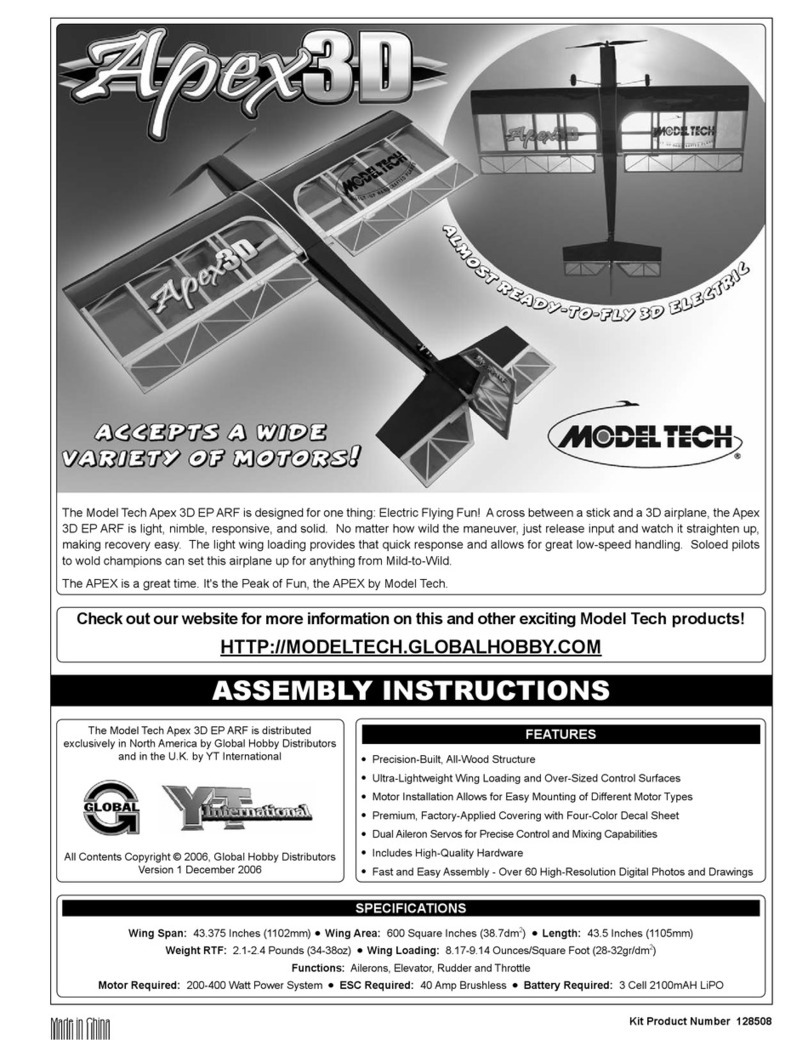Page 2 Page 19
These assembly instructions are designed to guide you through the entire assembly process of your new aircraft in the least amount of
time possible. Along the way you'll learn how to properly assemble your new aircraft and also learn tips that will help you in the future.
We have listed some of our recommendations below. Please read through them before beginning assembly.
lPlease read through each step before beginning assembly. You
should nd the layout very complete and straightforward. Our goal
is to guide you through assembly without any of the headaches and
hassles that you might expect.
lThere are check boxes next to each procedure. After you
complete a procedure, check off the box. This will help prevent you
from losing your place.
lCover your work table with brown paper or a soft cloth, both to
protect the table and to protect the parts.
lKeep a couple of small bowls or jars handy to put the small parts
in after you open the accessory bags.
lWe're all excited to get a new aircraft in the air, but take your
time. This will ensure you build a straight, strong and great ying
aircraft.
lIf you come across this symbol +, it means that this is an
important point or an assembly hint.
This R/C aircraft is not a toy! If misused or abused, it can cause serious bodily injury and/or damage to property. Fly only in open
areas and preferably at a dedicated R/C ying site. We suggest having a qualied instructor carefully inspect your aircraft before its rst
ight. Please carefully read and follow all instructions included with this aircraft, your radio control system and any other components
purchased separately.
Model Tech guarantees this kit to be free from defects in both material and workmanship at the date of purchase. This does not cover any component
parts damaged by use, misuse or modication. In no case shall Model Tech's liability exceed the original cost of the purchased kit.
In that Model Tech has no control over the nal assembly or material used for nal assembly, no liability shall be assumed for any damage resulting from
the use by the user of the nal user-assembled product. By the act of using the nal user-assembled product, the user accepts all resulting liability.
TABLE OF CONTENTS
INTRODUCTION
SAFETY WARNING
OUR GUARANTEE
INTRODUCTION.......................................................................... 2
SAFETY WARNING .....................................................................2
OUR GUARANTEE ...................................................................... 2
OUR RECOMMENDATIONS .......................................................3
A NOTE ABOUT COVERING MATERIAL ....................................3
LITHIUM POLYMER BATTERY WARNINGS - PLEASE READ... 4
TOOLS AND SUPPLIES REQUIRED ..........................................5
KIT CONTENTS ........................................................................... 5
TIPS FROM THE PROS...............................................................6
CONTROL SURFACE HINGING..................................................6
ELEVON CONTROL SYSTEM INSTALLATION........................... 7
LANDING SKID AND MOTOR INSTALLATION ...........................9
VERTICAL STABILISERS INSTALLATION ................................12
FINAL ASSEMBLY......................................................................13
C/G AND BALANCING ...............................................................15
AIRCRAFT SETUP INFORMATION...........................................15
CONTROL THROWS ................................................................. 16
PREFLIGHT CHECK AND SAFETY .......................................... 17
REPLACEMENT PARTS LIST ...................................................17
PRODUCT EVALUATION SHEET..............................................19
PRODUCT EVALUATION SHEET
Telling us what you like and don't like determines what model kits we make and how we make them. We would appreciate it if you would take a few
minutes of your time to answer the following questions about this kit and your modeling interests. Simply fold this form on the dotted lines, seal with
tape and mail it to us. Do not use staples and make sure our address faces out.
Global Hobby Distributors will not disclose the information it collects to outside parties. Global Hobby Distributors does not sell,
trade, or rent your personal information to others. Your privacy is important to us.
1) Kit: Model Tech Mini Mach Racer EP ARF # MT3211C
2) Where did you learn about this kit?
qMagazine Ads qFriend
qHobby Shop qOther
qInternet
3) What inuenced you the most to buy this kit?
qMagazine Ads qPrice
qType of Model qBox Art
qRecommendation qOther
qInternet
4) Did you have any trouble understanding the written instructions? If
yes, please explain.
qYes qNo
________________________________________________
________________________________________________
________________________________________________
________________________________________________
5) Did you have any trouble understanding any of the photographs?
If yes, please explain.
qYes qNo
________________________________________________
________________________________________________
________________________________________________
________________________________________________
6) Were any of the kit parts:
qDamaged qWrong Size
qMissing qWrong Shape
If you checked any of the boxes above, did you contact our
Customer Service Department to resolve the problem?
qYes qNo
7) Was any of the assembly difcult for you? If yes, please explain.
qYes qNo
________________________________________________
________________________________________________
________________________________________________
________________________________________________
8) What did you like most about this kit?
qAssembly Manual qParts Fit
qHardware Supplied qPrice
qOther
9) What did you like least about this kit?
qAssembly Manual qParts Fit
qHardware Supplied qPrice
qOther
10) Are you satised with the nished model? If no, please explain.
qYes qNo
_______________________________________________
_______________________________________________
_______________________________________________
_______________________________________________
11) How does this kit compare to similar kits by other manufacturers?
qBetter qAs Good
What is Your Age Group:
q10 & Under q11 - 20 q21 - 30 q31 - 40 q41 - 50 q51 - 60 q61 - 70 q71 +
How Many Years Have You Been in the Hobby?
qLess than 1 q2 - 4 q5 - 7 q8 - 10 q11 - 15 q16 - 20 q20 or More
How Many Models Have You Purchased In the Last Year?
q0 - 1 q2 - 4 q5 - 7 q8 - 10 q10 or More
Please List any Other Modeling Interests or any Additional Information about This Product:
________________________________________________________________________________________________________________________
_________________________________________________________________________________________________________________________
________________________________________________________________________________________________________________________
_________________________________________________________________________________________________________________________
________________________________________________________________________________________________________________________
_________________________________________________________________________________________________________________________
________________________________________________________________________________________________________________________
_________________________________________________________________________________________________________________________
________________________________________________________________________________________________________________________
_________________________________________________________________________________________________________________________
________________________________________________________________________________________________________________________
QC #




























